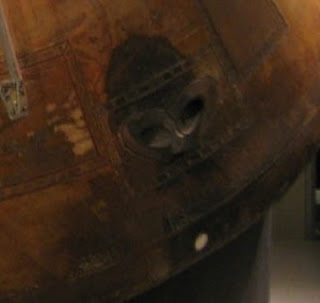 Apollo Boilerplate #1227 was one of many built by NASA to give to Navy and allied ships to train crews in the recovery of a wayward capsule. In an emergency, the Apollo spacecraft could be brought home earlier, even on land (though very hard on the astronauts!) and NASA wanted friendly help available, wherever it may be. Crews needed to be adept at stabilizing the capsule with a floatation collar, extracting the astronauts, and hauling the capsule on board. In 1970, BP-1127 was being used for training by a UK naval vessel when it became lost at sea. The circumstances surrounding this loss are unclear: bad weather and choppy seas, or perhaps a Soviet spy ship disguised as a fishing trawler grabbed it. Whatever the case, BP-1227 wound up in Soviet hands. Spy wise it had little value as the only thing inside these boilerplates was some ballast, and the size and shape were well known and available from many sources. Perhaps that is why the Soviets were amenable to it's return to the US. On September 8, 1970, the US Coast Guard icebreaker Southwin
Apollo Boilerplate #1227 was one of many built by NASA to give to Navy and allied ships to train crews in the recovery of a wayward capsule. In an emergency, the Apollo spacecraft could be brought home earlier, even on land (though very hard on the astronauts!) and NASA wanted friendly help available, wherever it may be. Crews needed to be adept at stabilizing the capsule with a floatation collar, extracting the astronauts, and hauling the capsule on board. In 1970, BP-1127 was being used for training by a UK naval vessel when it became lost at sea. The circumstances surrounding this loss are unclear: bad weather and choppy seas, or perhaps a Soviet spy ship disguised as a fishing trawler grabbed it. Whatever the case, BP-1227 wound up in Soviet hands. Spy wise it had little value as the only thing inside these boilerplates was some ballast, and the size and shape were well known and available from many sources. Perhaps that is why the Soviets were amenable to it's return to the US. On September 8, 1970, the US Coast Guard icebreaker Southwin d visited Murmansk as a port of call during a six month arctic survey. They were surprised when, with a considerable amount of hoopla, they were presented with the Apollo capsule.
d visited Murmansk as a port of call during a six month arctic survey. They were surprised when, with a considerable amount of hoopla, they were presented with the Apollo capsule. Space Capsule to Time Capsule
The capsule made its way back to the states. Its history at this point is unclear, but not where it wound up. It was turned over the the Smithsonian's National Air and Space Museum and within a few years it found a home in Grand Rapids, Michigan. There (or possibly in NASM hands) it was fitted with a conical nose cone to cover the parachute compartment and give it the iconic Apollo shape. It was filled with memorabilia collected by local high schools and sealed on December 31, 1976 as a Time Capsule to be opened on our nation's Tricentennial on July 4, 2076. It originally sat in the median of a boulevard in downtown Grand Rapids, but has since moved to a logical and more accessible display area in front of the Public Museum of Grand Rapids. There, it welcomes visitors to the museum and the Roger B. Chaffee Planetarium. At least for another 67 years.



























